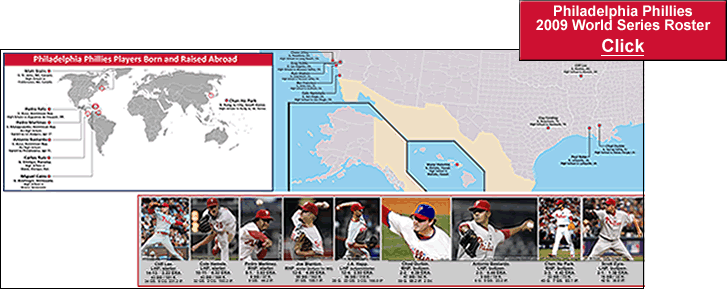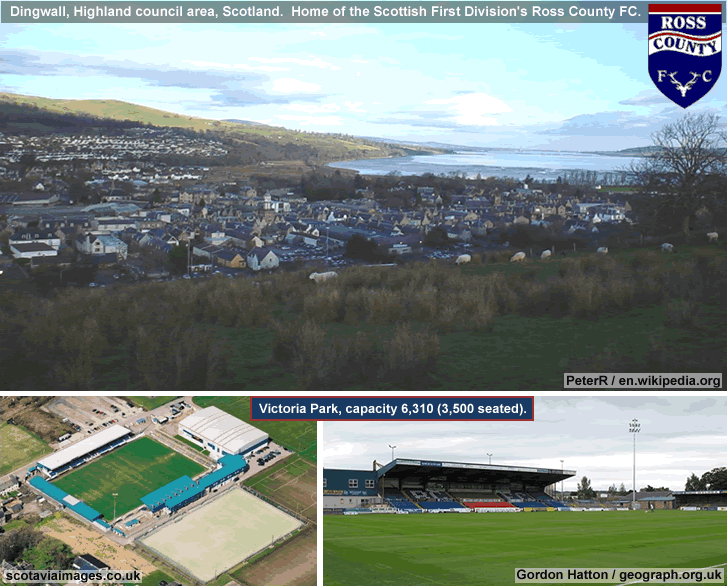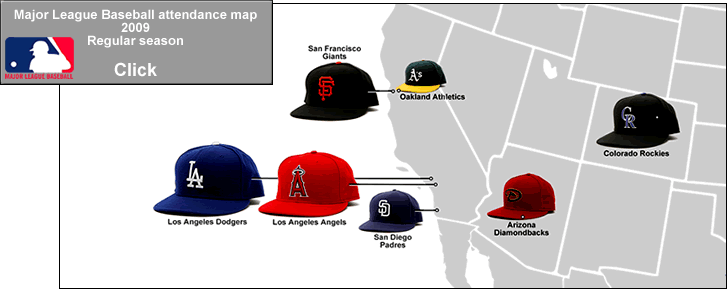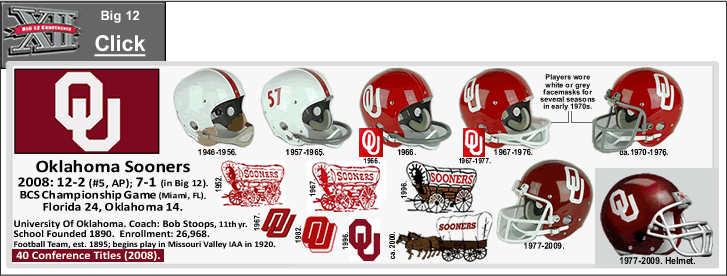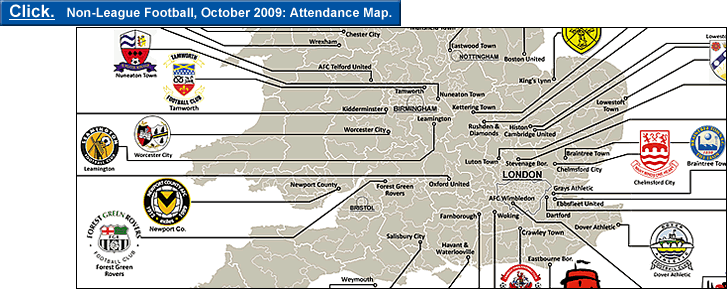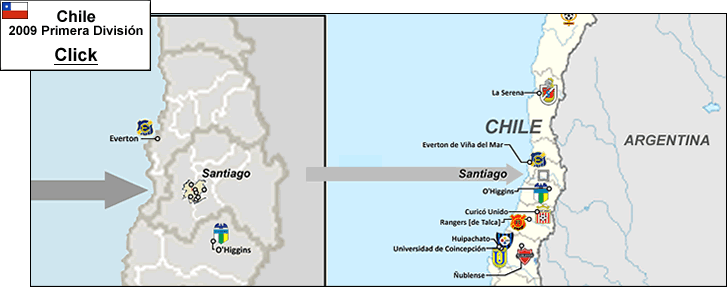
The Primera Divisón de Chile has its roots in the Liga Profesional de Football de Santiago, which was formed in May, 1933. Of the 8 founding clubs of the league, 3 are currently in the 2009 Primera División de Chile: Audax Italiano, Colo Colo, and Union Española.
Primera División de Chile Standings [2009 Clausura] {click here (ESPN Soccernet)}.
The Primera División de Chile is the top tier of football in Chile. There are 18 teams in the league, with 2 to 4 teams relegated to Primera B each year after the conclusion of the Clausura and the promotion/relegation playoffs. The league adopted the Mexican system in 2002, with regular season round-robin formats for the Apertura (starting in January) and Clausura (starting in July), followed by 8-team playoffs in June and December. The 2009 Apertura champions are the well-supported club Universidad de Chile, who draw around 14,000 per game. Universidad de Chile has won 13 Primera División de Chile titles, and are from the capital and largest city, Santiago (population: 5,428,000; 2002 census). Universidad de Chile has thus qualified for the 2010 Copa Libertadores, as will the 2009 Clausura playoffs winner, as well as the best-placed non-champion from the 2009 Clausura regular-season general table.
Current 2009 Clausura regular season leaders are another club from Santiago, CD Universidad Católica. Universidad Católica draw third best in the country, averaging 8,800 per game this year, and will be on their way to the 2010 Copa Liberatadores if they remain in first place. Universidad Católica has won 9 Primera División de Chile titles, their most recent in 2002, and are from the eastern and more affluent section of Greater Santiago called Los Condes. Universidad Católica have the second most Copa Llibertadores appearances by a club from Chile: 21, including finalists in 1993, when they fell to São Paulo of Brazil, 5-3 on aggregate.

Currently in second place are Audax Italiano, a club which was founded by Italian residents of Santiago in 1910, and which has won 4 Primera División de Chile titles (but none since 1957). In third place are Universidad de Concepción, from the third-largest metropolitan area in Chile, Concepción. In fourth place are the tiny club from the southern outskirts of the capital, Santiago Morning, who won one championship 67 years ago, and have a current average gate of just under 1,500.
There has only been one Chilean club that has won the Copa Libertadores, Colo Colo, who won the most prestigous South American title in 1991. Colo Colo are named after the legendary Chilean Mapuche chief. [The Mapuche are the indigenous inhabitants of central and southern Chile and Patagonian Argentina, and were known as the Araucanians by the Spaniards.] Santiago’s Colo Colo are the biggest and most successful club in Chile, with 28 Chilean titles (last in 2008-Clausura), and have recently averaged around 15,000 per game. Colo Colo actually can draw higher in the domestic league, in the low 20,000s, but their participation in the 2009 Copa Libertadores drew crowds towards these matches at the expense of their ’09 Apertura matches. Colo Colo have made 27 appearances in the Copa Libertadores, the most by any club from Chile.
-
The most distinctive thing about the nation of Chile is, of course, it’s very long and very narrow shape. Chile’s size is 4,300 km. (2,700 mi.) long, with an average width of only 175 km. (109 mi.). Throughout Chile, the variations in climate pretty much run the gamut, from the world’s driest desert in the north, the Atacama Desert, to a Mediterranean climate in the center, to a rainy temperate climate in the south, to a much colder climate with a meandering coastline featuring fjords and glaciers in the far south. And all along the eastern border are the towering Andes Mountains.
-
Clubs in the Primera División Chilena 2009 are not surprisingly concentrated in the more-populated central region that includes the three largest cities of Santiago, Valparaiso, and Concepción. 7 clubs are from Greater Santiago, with two more clubs within 100 kilometers of the capital: Everton de Viña del Mar, and O’Higgins. CD O’Higgins are named after the South American independence leader Bernardo O’Higgins Riquelme (who actually never met his father, who was born in County Sligo, Ireland). O’Higgins are from Rancagua, Cachapoal province, O’Higgins Region (metro area population: 236,000, the 7th largest in Chile).
Everton de Viña del Mar are named after the club from Liverpool, England…Everton FC. The club was formed by visiting sailors from Merseyside, in 1909. The town of Viña del Mar is a tourist destination whose name translates as ‘vineyard of the sea’, and is part of Greater Valparaiso, the second largest metropolitan area in Chile (803,000 population). Everton won the 2008 Apertura, their fourth Chilean title. The club gets decent support, averaging 7,200 this year.
There are two more clubs from the central region that needs mentioning, because both these greater Santiago-based clubs have won championships. 6-time champions Unión Española, hail from the Independencia district of Santiago. The club’s kits mirror those of the Spain national football team (dark red jersey/gold trim/navy pants). Unión Española draw crowds in the mid 4,000s. CD Palestino have won 2 titles, their first in 1955, and their second in 1978. The club was founded in 1920 by Palestinian immigrants. Palestino just missed out on another league title last December, losing to Colo-Colo 4-2 on aggregate in the playoffs final. This year the club are in a relegation battle, just two points above the relegation/promotion playoffs.
-
South of this Santiago/Valparaiso/Rancagua cluster of 9 clubs, there are 5 clubs in the 2009 Primera división de Chile, including two clubs from Greater Concepción: Universidad de Concepción, and CD Huachipato. Huachipato won the championship in 1974, and are the only club from south of Santiago to have won a title. A steel company club originally, they are in fact nicknamed the Steelers. Their crest incorporates the ‘Steelmark’ logo which the NFL’s Pittsburgh Steelers use as their primary logo, and which is owned by the American Iron and Steel Institute {see this, which includes a mention of CD Huachipato near the end of the page}.
The current highest-drawing club from this south-central region of Chile is CD Ñublense, from the 10th-largest city in the country, Chilan (population: 165,000). Ñublense have averaged around 6,000 per game in 2009, but are third-bottom, in the relegation/promotion playoff spots.
-
North of the central/capital region there are four clubs currently in Chile’s top tier, including two clubs from the extremely arid, and mineral-rich, Atacama Desert. CD Cobreloa, established 1977, are from the city of Calama, El Loa Province, Antofagasta Region (population: 143,000), Cobreola have won 8 Primera Divisón de Chile titles (!), their most recent in the 2004 Clausura. Their all-orange kit symbolizes the region’s copper mining; indeed their name combines the Spanish word for copper (cobre) , and the nearby Loa River.
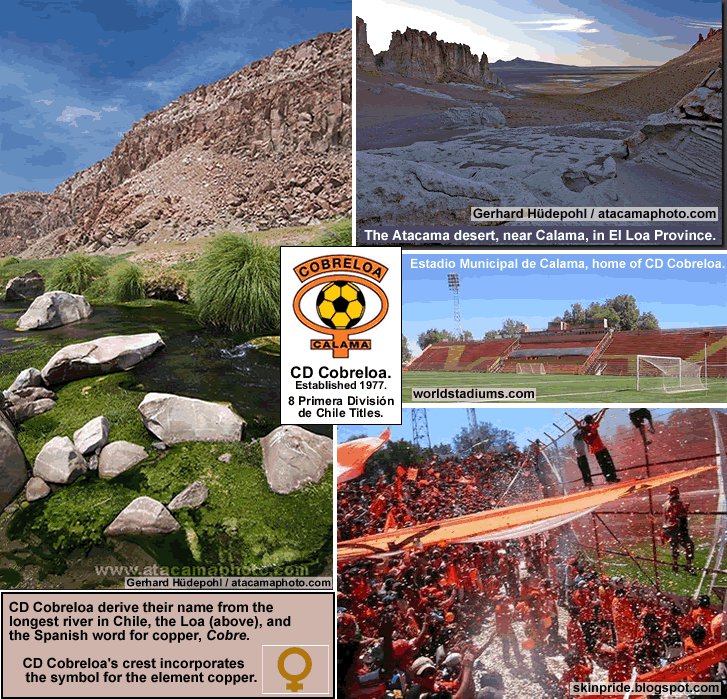
Entering Chile’s top flight in 1978, one season after their inception, Cobreloa won their first title in their fourth year, in 1980. Cobreloa then made it to two consecutive Copa Libertadores finals, losing to Flamengo (Brazil) in 1981, and to Peñarol (Uruguay) in 1982. The club has made 13 appearances in the Copa Libertadores. Cobreloa have never been relegated, and these days the club draws aroumd 3,400 per game.
The other club from the Atacama Desert are from the tiny mining town of El Salvador (population: 7,000), and are named CD Cobresal. Cobresal mimics Cobreloa in nomenclature, colors and crest (adding a jaunty miner’s helmet to the symbol for copper that dominates both crests). Cobresal play in a stadium that has a larger capacity than the town’s population. The tiny club have managed to stay in the Primera División for 18 seasons, their current spell starting in 2002. The club has made one Copa Libertadores appearance (in 1986). Due to their remote desert location, Cobresal are not surprisingly at the bottom of the attendance table, but not, crucially, the league table, and it looks like these minnows from the driest place on Earth have a solid chance at surviving another season in the first division.
Primera División Chilena, Relegation table {click here}.
The same cannot be said for the northern-most club in the 2009 Primera División de Chile. They are Municipal Iquique, from Iquique, Tarapaca Region (population: 164,000). This city is the center of Chile’s sodium nitrate (aka saltpeter) mining industry [sodium nitrate is mined for it's many uses in fertilizers, glass production, pyrotechnics, and food preservatives]. Municipal Iquique’s current spell of 2 seasons in the top flight will end, unless they can improve on their alarming record of zero wins, 5 draws and 9 losses. The club has drawn well this year, though, fifth-highest, at 6,400 per game.
Thanks to the contributors to the pages at en.wikipedia.org {click here (set at Primera División Chilena 2009 page) and es.wikipedia.org {click here (set at Torneo Clausura 2009 (Chile) page)}. Thanks to Football-Lineups.com, for attendance figures {click here}.
Thanks to AtacamaPhoto.com, photos by Gerhard Hüdepohl {click here}. Thanks to PlatformaUrbana.cl {click here}. Thanks to SkinPride StreetRockZine Chile {click here, ‘Hinchadas de Chile II’}.
Thanks to Bruno Eduardo Nunez, for submitting a request in the Comments section here, for a map of Primera Divisón Chilena.


